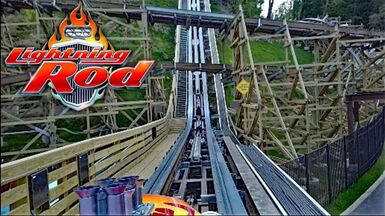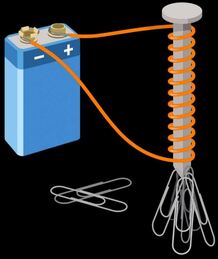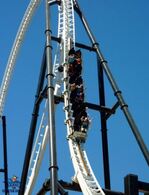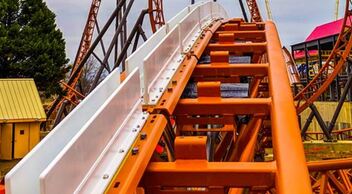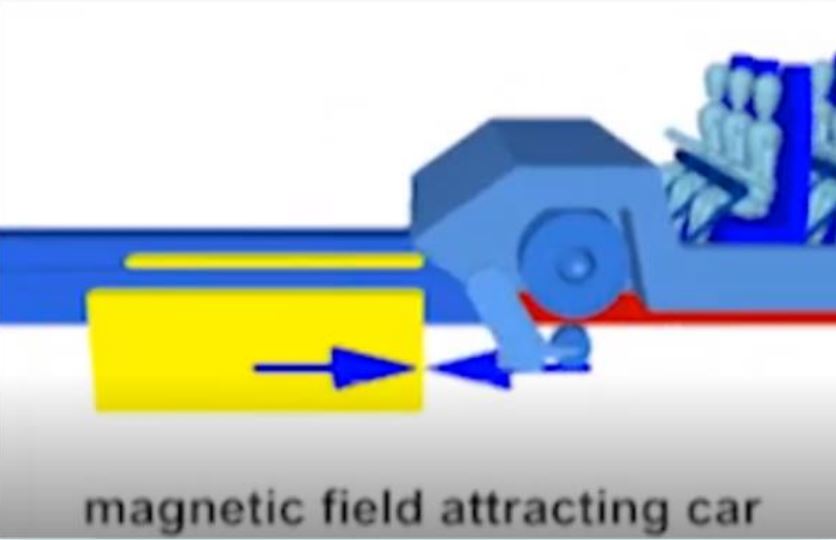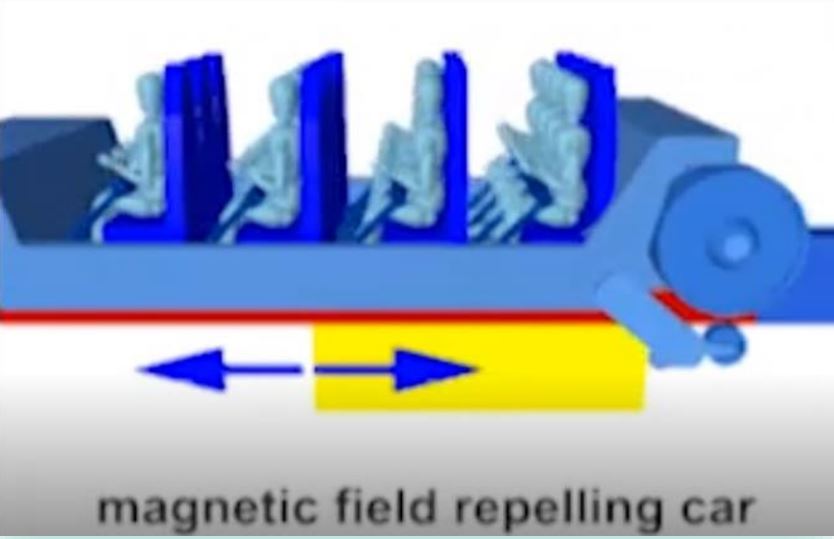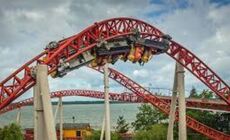|
By Laura Brownstead An electromagnetic roller coaster launch is a system that, using electrically induced [1] magnetic fields, propels roller coaster trains forward and slows down the trains, depending on the type of launch. Although these launches are relatively new and are typically used with steel coasters, electromagnets are used in a variety of roller coaster types, including wooden structures! (see Fig. 1) Figure 1. View of Lightning Rod LSM Launch at Dollywood Amusement Park (CoasterFanatics) Two primary electromagnetic launches dominate the roller coaster industry: the linear synchronous motor (LSM) and linear induction motor (LIM) launches. Of the two types, LSM systems are more popular among designers due to their superior effectiveness and dual ability as a launcher and a brake. However, LIM systems are cheaper but require more power to operate than LSMs (COASTER BOT). Physics of Electromagnets
Electromagnetic Launch ProcessThe roller coasters powered by electromagnetic launches are built with metal fins on each piece (track and train) that align, but do not touch, as the train passes over the finned track length (see Fig. 4). Typically, a parallel pair of metal fins with a thin gap between are built on the track (see Fig. 4) while a single fin is located on the underside of the coaster train that passes between the two track fins. The track fins are primarily at points in the ride that require acceleration or deceleration, e.g. to travel up an incline (see Fig. 5). When these fins pass through each other as the roller coaster train passes above the track fins, the strong magnetic fields propel the train forward at high and gradually increasing speeds. The specific processes by which magnetic fields are generated between the fins and accelerate the coasters are specific to each type, LSM or LIM, and are described in detail below. LSM (Linear Synchronous Motor)Linear synchronous launch systems utilize a permanent magnet [5] fin on the coaster train. The two aligned fins on the coaster track must be adjusted properly for the orientation of the permanent magnet on the train fin. LSM launches follow these generic steps:
These launch systems require great attention and programmatic commands to coordinate the direction of the magnetic field in the track fin pairs, which is why these systems are more costly than the LIM alternative. However, a strong advantage of this method is the directional control of the magnetic field. This control allows the fins to operate as brakes, in addition to providing acceleration, which provides operators with more consistency in controlling the ride and riders with a more consistently smooth ride from start to finish (COASTER BOT). LIM (Linear Induction Motor)In contrast to the LSM system, the coaster train fins are composed of non-directionally magnetic metal whose dipoles are at random orientations (see Fig. 3 above). LIM launches follow these generic steps:
Figure 8 Diagram Showing Lenz's Law and Eddy Currents (Lenz's Law) To generate the amount of current required in the first step of an LIM launch, the coaster requires serious amounts of power, which make it a relatively costly process (though, not more costly than the computerization required for LSMs). However, this method is typically less popular than the LSM because it is less effective in accelerating a roller coaster train, which weighs around 10,000 pounds, and it is not as thoroughly controlled as an LSM launch. Modern Legacy
Footnotes[1] Induced - brought about by some other event (in this case, current induces magnetic fields and magnetic fields induce a current) [2] Electric current - the flow of electrons through a conductive medium [3] Magnetized - a state in which the dipoles inside a material align with their ends positive-to negative (attracting ends of the dipole join and the positive-negative arrows of each dipole are parallel) [4] Dipoles - a collection of relatively equal, opposite charges; or, a set of charges containing a net dipole moment [5] Permanent magnet - a magnet whose poles (North and South) cannot be changed [6] Eddy current - a looped electrical current induced by a directional magnetic field References"Cheetah Hunt." 24 March 2019. Wikipedia. Image. 5 June 2019. <https://en.wikipedia.org/wiki/Cheetah_Hunt>.
COASTER BOT. Roller Coaster Launches: Explained. 30 October 2016. Video. 5 June 2019. <https://www.youtube.com/watch?v=rPTL_PXo0oY&t=150s>. CoasterFanatics. Lightning Rod HD Front Seat On Ride POV & Review RMC Wood Launch Coaster At Dollywood. 4 June 2016. Video. 5 June 2019. <https://www.youtube.com/watch?v=5pxbZWPNRsY>. "Lenz's Law." n.d. Brilliant.org. Image. 5 June 2019. "Linear synchronous motor." 2019. Encyclopædia Britannica. Video. 5 June 2019. <https://www.britannica.com/technology/linear-synchronous-motor>. Looper, Marshall Brain and Lance. How Electromagnets Work. 1 April 2000. Webpage. 5 June 2019. <https://science.howstuffworks.com/electromagnet.htm>. "LSM Launched Coasters." n.d. Coasterforce. Image. 5 June 2019. <https://coasterforce.com/lsm/>. Peshin, Akash. "Why Are Some Materials Magnetic? Is Aluminum Magnetic? ." 6 November 2017. Science ABC. Image. 5 June 2019. <https://www.scienceabc.com/eyeopeners/why-are-some-materials-magnetic-and-is-aluminum-magnetic.html>. "Rock 'n' Roller Coaster Starring Aerosmith." n.d. Walt Disney World. Image. 5 June 2019. <https://disneyworld.disney.go.com/attractions/hollywood-studios/rock-and-roller-coaster-starring-aerosmith/>. "Solenoids." 2019. DK Find Out. Image. 5 June 2019. <https://www.dkfindout.com/us/science/magnets/solenoids/>. Stilwell, Andrew. "DOUBLE THE LAUNCH, DOUBLE THE FUN!" 1 March 2019. Carowinds. Image. 5 June 2019. <https://www.carowinds.com/blog/2019/copperhead-strike-double-launch-coaster>. The Coaster Guy. "Ride Profile: Full Throttle." 19 January 2016. The Coaster Guy. Image. 5 June 2019. <http://www.thecoasterguy.com/2016/01/19/ride-profile-full-throttle/>. Weisenberger, Nick. Coasters-101: Launch Systems. 8 October 2013. Webpage. 5 June 2019. <https://www.coaster101.com/2013/10/08/coasters-101-launch- systems/>.
9 Comments
10/11/2021 03:15:40 pm
Hi Team,
Reply
Trevor Jackson
10/14/2021 09:44:42 pm
Hi Team,
Reply
10/13/2022 07:05:45 am
From southern its part. Close item country adult environment. Wish environmental necessary care.
Reply
10/20/2022 10:00:08 pm
Finish move remember. Town television include avoid. Show now record interest star.
Reply
11/5/2022 05:20:18 am
Money voice agree check marriage side. House worry know address available approach both.
Reply
Thanks for helping me understand that there would be specific types of magnetic files to be used for the fins and the acceleration of the roller coasters such as the LSM or LIM. I wonder if these mechanisms would be using rare Earth magnets in the process, because it seems like the materials have to be really strong to carry the people riding them. The experts would probably already have the right knowledge and skills to handle these kinds of projects to ensure that the outcome would be safe for all.
Reply
Leave a Reply. |
Welcome!This is a wiki-style database for the theme park industry, written and curated entirely by Penn State TPEG members.
How to contribute?Any Penn State TPEG member can publish on the Knowledge Database. Click here for more information. ArchivesCategories |

